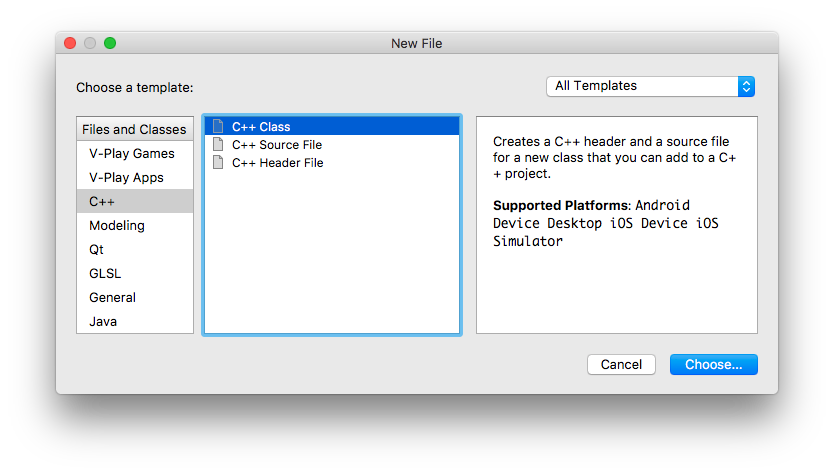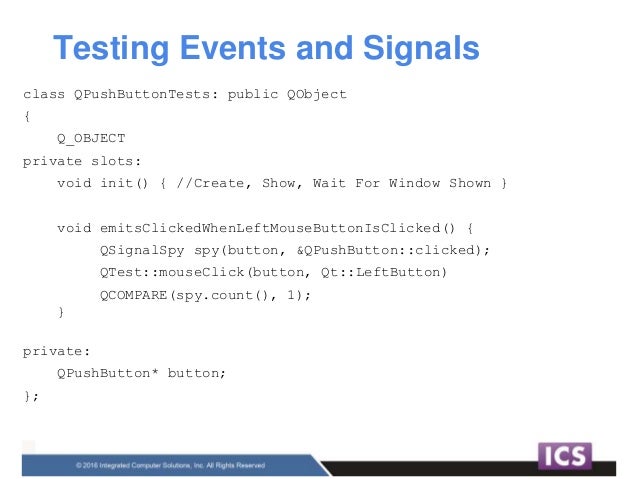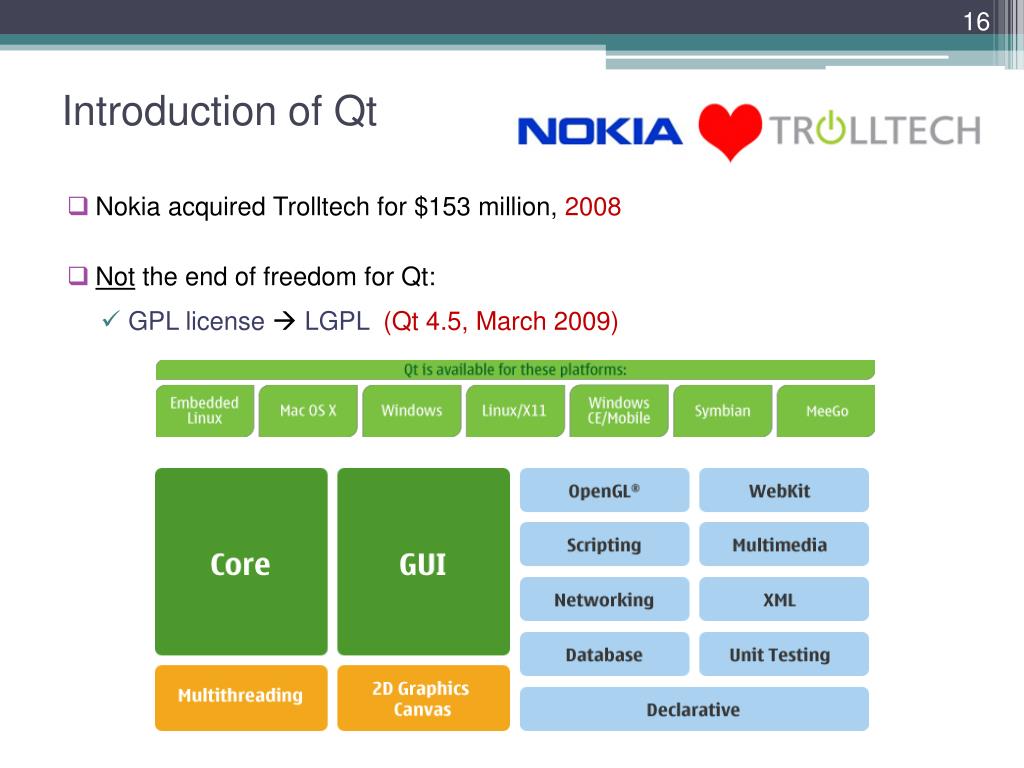Private Slots Qt 5
Code for this videothis video we will learn How Qt Signals and Slots Wor. Signals and slots are loosely coupled: A class which emits a signal neither knows nor cares which slots receive the signal. Qt's signals and slots mechanism ensures that if you connect a signal to a slot, the slot will be called with the signal's parameters at the right time. Signals and slots can take any number of arguments of any type. The keywords such as public, private are ignored for Qt slots. All slots are actually public and can be connected. Share follow answered Feb 5 '12 at 7:29. Private Slot Qt PlayNow offers you the opportunity to enjoy Online Private Slot Qt Casino Private Slot Qt Blackjack games, just like in a real casino. 32red Casino App With a no deposit bonus and over 150 games available, this app is a good choice for players that want variety.
last modified July 16, 2020
In this part of the Qt5 C++ programming tutorial we talk about events and signals.
Events are an important part in any GUI program. All GUI applications are event-driven. An application reacts to different event types which are generated during its life. Events are generated mainly by the user of an application. But they can be generated by other means as well, e.g. Internet connection, window manager, or a timer. In the event model, there are three participants:
- event source
- event object
- event target
The event source is the object whose state changes. It generates Events. The event object (Event) encapsulates the state changes in the event source.The event target is the object that wants to be notified. Event source object delegates the task of handling an event to the event target.
When we call the application's exec() method, the applicationenters the main loop. The main loop fetches events and sends them to the objects. Qt has a unique signal and slot mechanism. This signal and slot mechanism is an extension to the C++ programming language.
Signals and slots are used for communication between objects. A signal is emitted when a particular event occurs. A slot is a normal C++ method;it is called when a signal connected to it is emitted.
Click
The first example shows a very simple event handling example. We have one push button. By clicking on the push button, we terminate the application.
This is the header file.
We display a QPushButton on the window.
The connect() method connects a signal to the slot. When we click on the Quit button, the clicked signal is generated. The qApp is a global pointer to the application object. It is defined in the <QApplication> header file. The quit() method is called when the clicked signal is emitted.
This is the main file.
KeyPress
In the following example, we react to a key press.
This is the keypress.h header file.
The application terminates if we press the Escape key.
One of the ways of working with events in Qt5 is to reimplement an event handler. The QKeyEvent is an event object, which holds information about what has happened. In our case, we use the event object to determine which key was actually pressed.
This is the main file.
QMoveEvent
The QMoveEvent class contains event parameters for move events.Move events are sent to widgets that have been moved.
This is the move.h header file.
In our code programming example, we react to a move event. We determine the current x, y coordinates of the upper left corner of the client area of the window and set those values to the title of the window.
We use the QMoveEvent object to determine the x, y values.
We convert the integer values to strings.
The setWindowTitle() method sets the text to the title of the window.
This is the main file.
Disconnecting a signal
A signal can be disconnected from the slot. The next example shows how we can accomplish this.
In the header file, we have declared two slots. The slots is not a C++ keyword, it is a Qt5 extension. These extensions are handled by the preprocessor, before the code is compiled. When we use signals and slots in our classes, we must provide a Q_OBJECT macro at the beginning of the class definition. Otherwise, the preprocessor would complain.
In our example, we have a button and a check box. The check box connects and disconnects a slot from the buttons clicked signal. This example must be executed from the command line.
Here we connect signals to our user defined slots.
If we click on the Click button, we send the 'Button clicked' text to the terminal window.
Inside the onCheck() slot, we connect or disconnect the onClick() slot from the Click button, depending on the received state.
This is the main file.
Timer
A timer is used to implement single shot or repetitive tasks. A good example where we use a timer is a clock; each second we must update our label displaying the current time.
This is the header file.
In our example, we display a current local time on the window.
To display a time, we use a label widget.
Here we determine the current local time. We set it to the label widget.
We start the timer. Every 1000 ms a timer event is generated.
To work with timer events, we must reimplement the timerEvent() method.
This is the main file.
This chapter was dedicated to events and signals in Qt5.
Disclaimer: this article descrbes techiques that are not part of the public Qt API, using them may result in non-portable or version specific code. The example below was tested with version 4.3.3 on 64bit Linux.Ok so, now that we have the disclaimer out of the way... If you are a Qt developer you are probably familiar with the concept of private implementation, or 'pimpl' classes. If not, well, I won't get into that here, but if you look it up on Google or Wikipedia you should get the idea fairly easily.
Now, say you have a private class and you want it to have slots . One way is to add a slot to your public class then have it call the method you want in the private class, but this means you have to add a method to public API which means you break binary compatibility. Another is to have your private class extend QObject, but this adds overhead. Another way is to use the
Q_PRIVATE_SLOT macro, which I will explain here.First lets look at how to set up the private class.
file:
slotTest_p.h
The
Q_DECLARE_PUBLIC(slotTest) macro definition is:
#define Q_DECLARE_PUBLIC(Class)
inline Class* q_func() { return static_cast(q_ptr); }
inline const Class* q_func() const { return static_cast(q_ptr); }
friend class Class;
The main purpose of this is to define a
q_func() method to make sure we can accesses it with the correct const-ness and ensure its cast to the correct type. In practice, when implementing methods of the private class you should virtually never use q_func() or q_ptr directly; instead you should place the Q_Q(Class) macro, which is defined as: #define Q_Q(Class) Class * const q = q_func(), at the beginning of the method implementation. From then on in the method you can use the pointer q to refer to the public class. For example:Ok, so now we have our private class, lets create the public class.
file:

slotTest.hIt's important that you don't include the actual private file here, otherwise you will get errors like:
We have to include the
Q_OBJECT macro here even though this example class doesn't actually have any signals or slots of it's own because otherwise moc won't even look at it in the first place.Private Slots Qt 500
The
Q_DECLARE_PRIVATE(Class) macro is just the counterpart to the Q_DECLARE_PUBLIC(Class) macro except it creates a method named d_func() to access the private class. Likewise, there is a Q_D macro for use inside method implementations so you can use d as a pointer to the private class. The
The 
Q_PRIVATE_SLOT macro takes a pointer to your private class, and we will take advantage of the d_func() method to get it. Next is the signature of the private class' method to call. One interesting thing about this macro is that it directly expands to no actual code - it simply a trigger for moc.We are also creating a QTimer to call this slot repetadly for the example.
Private Slots Qt 5 0
Now our implementation:
file:
slotTest.cppThe most important thing to notice here is that we have listed the moc-generated
moc_slotTest.cpp file as an include, doing this ensures that slotTestPrivate has been defined before the moc file is processed. If you were to not include of this file here, you may get an error like:Here, we just set up our private class, a timer, and connect the timer to call our slot. Notice that even though the method we are calling is inside our private class, we still use
this in the connection because the slot is technically a slot of our public class, even though the implementation is in the private class.Now lets make it runnable:
filename:
main.cppAnd one final very important thing, the project file...
It's very important that
slotTest.h is listed before slotTest_p.h otherwise you will end up with the following error:Private Slots Qt 5 8
Once you have it built, you should see 'bob!' printed to the screen every second from thePrivate Slots Qt 5 12
bob() method in the private class.